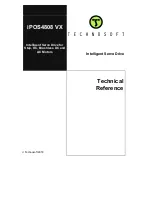
8.13 Manual Tuning
8.13.1 Tuning the Servo Gains
8-79
8
T
uning
Guidelines for Manually Tuning Servo Gains
When you manually adjust the parameters, make sure that you completely understand the
information in the product manual and use the following conditional expressions as guidelines.
The appropriate values of the parameter settings are influenced by the machine specifications,
so they cannot be determined universally. When you adjust the parameters, actually operate
the machine and use the S or analog monitor to monitor operating conditions. Even if
the status is stable while the Servomotor is stopped, an unstable condition may occur when an
operation reference is input. Therefore, input operation references and adjust the servo gains
as you operate the Servomotor.
Stable gain: Settings that provide a good balance between parameters.
However, if the load moment of inertia is large and the machine system contains
elements prone to vibration, you must sometimes use a setting that is somewhat
higher to prevent the machine from vibrating.
Critical gain: Settings for which the parameters affect each other
Depending on the machine conditions, overshooting and vibration may occur and
operation may not be stable. If the critical gain condition expressions are not met,
operation will become more unstable, and there is a risk of abnormal motor shaft
vibration and round-trip operation with a large amplitude. Always stay within the
critical gain conditions.
If you use the torque reference filter, second torque reference filter, and notch filters together,
the interference between the filters and the speed loop gain will be superimposed. Allow lee-
way in the adjustments.
When Pn10B = n.
0
(PI Control)
Guidelines are given below for gain settings 1.
The same guidelines apply to gain settings 2 (Pn104, Pn105, Pn106, and Pn412).
•
Speed Loop Gain (Pn100 [Hz]) and Position Loop Gain (Pn102 [/s])
Stable gain: Pn102 [/s]
≤
2
π
×
Pn100/4 [Hz]
Critical gain: Pn102 [/s] < 2
π
×
Pn100 [Hz]
•
Speed Loop Gain (Pn100 [Hz]) and Speed Loop Integral Time Constant (Pn101 [ms])
Stable gain: Pn101 [ms]
≥
4,000/(2
π
×
Pn100 [Hz])
Critical gain: Pn101 [ms] > 1,000/(2
π
×
Pn100 [Hz])
•
Speed Loop Gain (Pn100 [Hz]) and First Stage First Torque Reference Filter Time Constant
(Pn401 [ms])
Stable gain: Pn401 [ms]
≤
1,000/(2
π
×
Pn100 [Hz]
×
4)
Critical gain: Pn401 [ms] < 1,000/(2
π
×
Pn100 [Hz]
×
1)
•
Do not set notch filter frequencies (Pn409, Pn40C, Pn417, Pn41A, and Pn41D) that are close
to the speed loop’s response frequency. Set a frequency that is at least four times the speed
loop gain (Pn100). (However, Pn103 (Moment of Inertia Ratio) must be set correctly. If the set-
ting is not correct, vibration may occur and the machine may be damaged.
•
Change the notch filter frequencies (Pn409, Pn40C, Pn417, Pn41A, and Pn41D) only while the
Servomotor is stopped. Vibration may occur if a notch filter frequency is changed during oper-
ation.
The following adjusted value guidelines require that the setting of Pn103 (Moment of Inertia Ratio)
is correctly set for the actual machine.
Important
Important
















































